More on Varanasi:
👉 Where the Fires Burn – First Encounters with Varanasi captures the raw emotional power of first impressions.
👉 Journey Through Varanasi – Saturn, Sound, and Spirit explores a symbolic performance and the soul’s resonance with the sacred.
In the Shadow of Shiva: Aghori Encounters
As you may remember, for Mykola, there is no distinction between people. All are equal before God. After our encounter with the crematorium’s “caretaker,” we found ourselves next to a small tent adorned with pink inflatable balloons. I have no idea what occasion prompted such decoration, but it looked ironic as the dwelling of a young female Aghori—a contradiction.
The Aghori are an ascetic sect of Shaivites who pursue spiritual liberation by embracing all that is considered impure. They reject traditional concepts of good and evil, do not recognize the caste system, and strive for complete detachment from the material world. Aghoris are often seen at cremation ghats, meditating on the ashes of the dead and performing rituals that symbolize the transcendence of the fear of death.
Unlike other Hindu hermits, the Aghori deliberately seek out the “unclean”—they live among ashes, remains, and ritual leftovers that society rejects. This is not merely a provocation—it is their method of severing attachment to the material world and overcoming the duality of pure and impure. Their goal is to reach moksha (liberation) by directly confronting their fears and mental limitations.
The Woman with the Skull
Back to reality. The young Aghori woman was striking—beautiful and terrifying at once, partly due to her unique accessories. She held a human skull filled with the ashes of who knows how many bodies—not that it really mattered. Slim and dark-skinned, this native of Tamil Nadu resembled an ebony statue. She wore a black, dusty robe loosely draped from her shoulders, enhancing her ghostlike silhouette. Her long black hair was tied into a bun, revealing high cheekbones and a piercing, penetrating gaze.
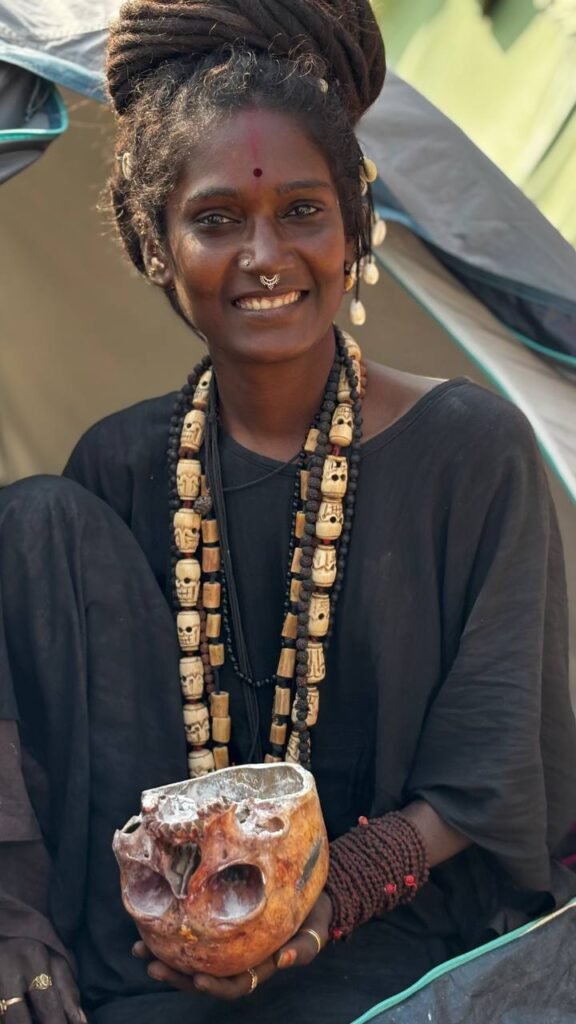
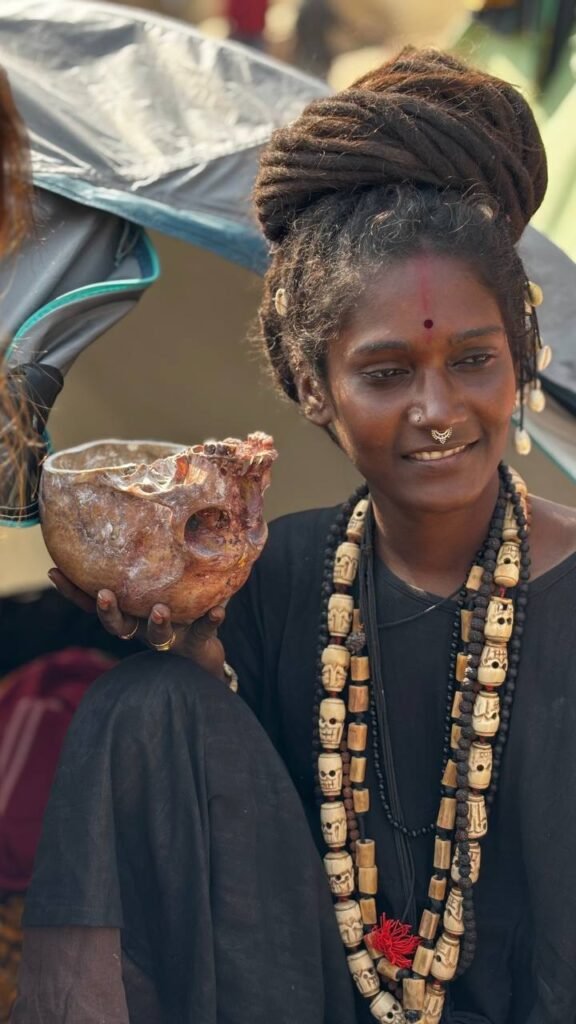
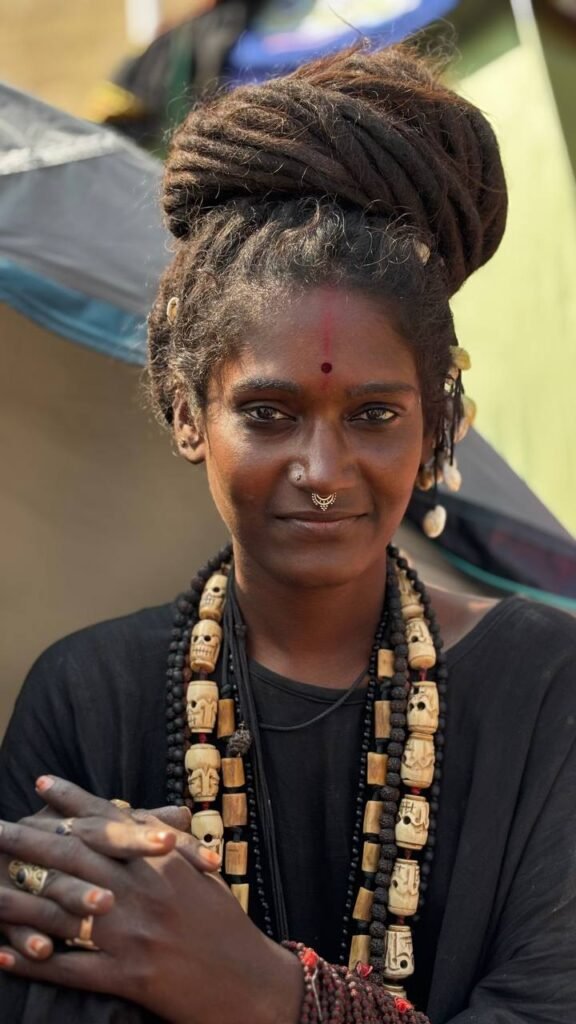
Around her neck hung a mundamala—a garland of small skulls symbolizing victory over death and detachment from the material world. In Shaivism, it is associated with Shiva. It is believed to grant spiritual power to those who wear it, helping them embrace impermanence and the inevitability of death as a path to liberation.
She looked at me calmly, without a trace of aggression or friendliness—just existing, like death itself, which in this city is regarded with the same casualness as everyday life.
Being near her was unsettling. Mykola cheerfully greeted her, while the rational Kirill stayed far enough away not to get involved in the jungle of unknown energies.
Interview with Death
This lady sat in a tent decorated with pink balloons, resolved not to save on impressions and plunged into every mind-rattling adventure. After encountering such an unfamiliar phenomenon, I wanted to understand it more deeply. Once freed, a word whispered seductively into my ear—the idea of conducting a kind of interview with my new acquaintance.
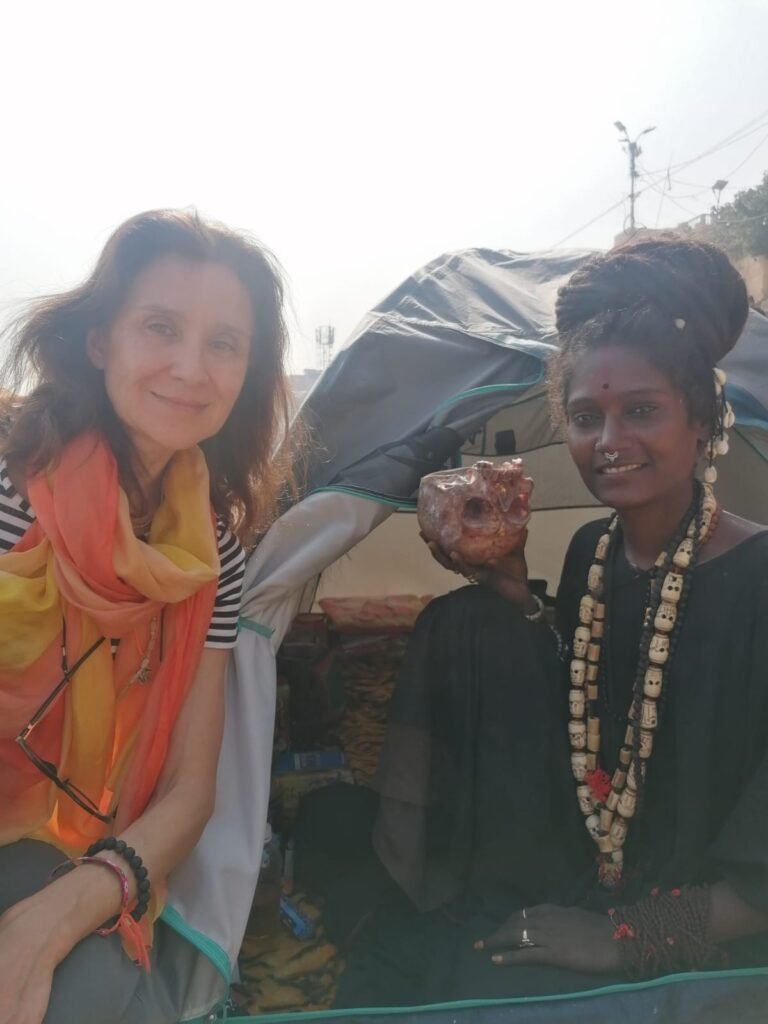
When I shared my thoughts with Mykola, I immediately received an enthusiastic “yes,” and we decided not to delay. It’s worth mentioning that we had no common language with the Aghori. According to Mykola, she spoke Tamil, but even this didn’t deter me.
Later, while walking along the riverbank—the stage for Varanasi’s endless theater—we arranged to meet our new acquaintance at noon.
Where Fear Ends: Meeting a Female Aghori
And so we returned to the dwelling of death. She sat fully dressed at the entrance of her small tent, alongside a friend who agreed to translate. As it turned out, our Aghori also spoke some English and was far less removed from civilization than one might assume. She put on glasses and pulled out a phone, softening the aura of death that undoubtedly followed her everywhere.
We discussed many topics, including how she came to follow the Aghori path. Her answer was direct and unexpected: she hadn’t chosen this path—it had been selected for her by God twenty years ago. She was about 38 at our meeting, born in the southern state of Tamil Nadu.
The Divine and the Dismissed: Struggles of a Woman in an Aghori World
When I asked her what it was like to be a woman in this tradition and what particular challenges she faced, she paused and answered with a hint of bitterness. She lacked respect,especially from Indian housewives, which she emphasized with a touch of disdain.
Unfortunately, I didn’t write down the answers immediately and now struggle to recall the details—especially since the language barrier complicated things. But one reply stuck in my memory: she said clearly that the Aghori path is the path to God—and that she is God.
She also told us that she stays in touch with her family and had even visited them a couple of years ago.
At the end of the interview, I gave her a small tip for her time and asked her to send me a few reflections in writing. We exchanged phone numbers, but I never received a reply. The life of a female Aghori is whole enough already.
About a month later, I learned that her tent had been set on fire—perhaps by rival male Aghoris. I don’t have definitive proof, but from what I heard, her growing popularity had become unacceptable to someone.
Whispers of Shiva Beyond the River
After meeting this extraordinary woman, our group headed to another intriguing location—an Aghori village.
We climbed into a boat and crossed to the other side of the Ganges. The midday sun shone brightly—it was nearly hot in Varanasi. The journey took about ten minutes.

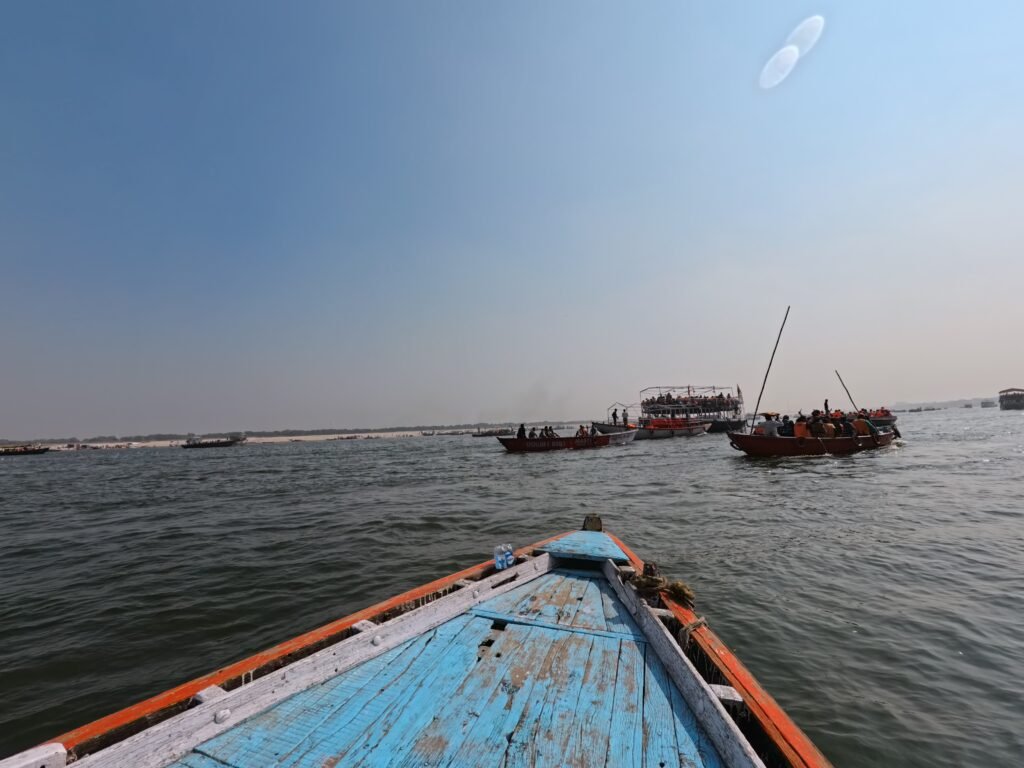
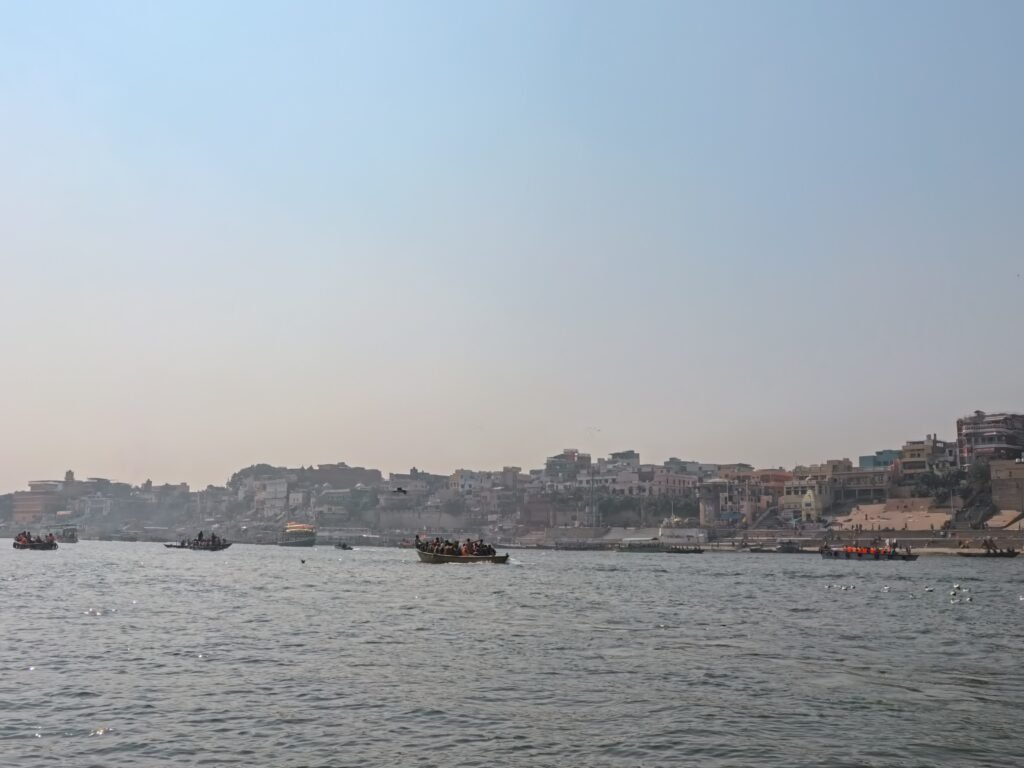
The opposite bank looked like something out of an Arabian tale—white sand exposed during the dry season, camels, boatmen, vendors, and all sorts of colorful people. But the area still felt desolate, perhaps because of its ambiguous energy. This was, after all, the domain of the Aghoris.
We walked across the sand for another twenty minutes before arriving at the village. Though technically open to visitors, Aghoris do not welcome random tourists. You must be sincere in your desire to understand their philosophy—or at least have a guide like Mykola. Otherwise, it’s better not to disturb the local harmony.
Despite its isolation, the village radiated a powerful spiritual energy. At its center stood a temple dedicated to various forms of Shakti—the feminine divine force, embodying both creation and destruction.
The Guru and His Visions
The head Aghori here appeared to be a person of great authority. Both disciples and locals came to him for blessings. He devoted nearly two hours to us—a rare gift.
Our visit began with a tour of the temple, where he introduced each goddess with warmth and affection. Rather than portraying them as distant deities, he spoke of them as living forces, present in the here and now.

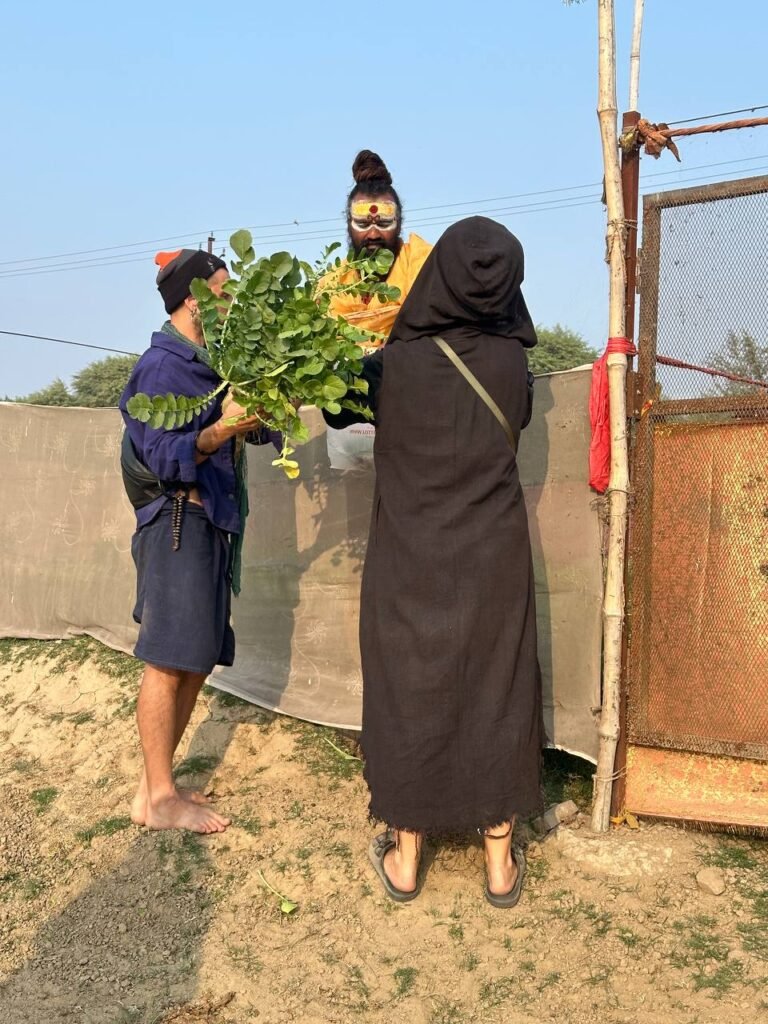

The temple’s atmosphere was strange to me—the sharp scent and smoke rising from the sacrificial altar, where something hissed in oil, made me think of human offerings. A couple of other Aghoris sat by the fire, smoking charas, the smell of which floated in the air. They kindly offered the chillum to all of us. Everyone politely declined—except for Mykola, whose resilience I’ve mentioned.
Aghoris traditionally smoke charas, a form of cannabis resin rolled into balls or sticks by hand. It’s considered a sacred substance in India, associated with Shiva. They may also use ganja (regular marijuana) and herbal blends mixed with oils or natural ingredients, usually smoked through a chillum—a traditional clay pipe, also linked to Shiva worship.
They believe these substances help induce meditative states, dissolve the illusion of the material world, and connect with higher consciousness.
Ganges, Charas, and the Royal Cobra: A Journey into Other Incarnations
Later, as we sat beneath a tree talking with the guru, he invited us to stand before him individually. Closing his eyes, he fell into deep concentration—almost a trance. After inhaling ganja, he revealed our past lives and suggested mantras for each of us.
There were five of us—Mykola, Kirill, myself, and two of Mykola’s friends—and none of our past lives repeated. Interestingly, the guru said Kyrylo and I had similar past incarnations—he was some royal serpent, and I was a royal cobra—an amusing coincidence. Once again, mysticism—or simply the norm in India—entered my still-skeptical mind.
In this regard, Mykola was a constant delight. He approached all local miracles with healthy equilibrium. On the other hand, I struggled to grasp the nature of what was happening. A month later, in the entirely civilized setting of Fort Kochi in Kerala, several details of my current life strangely aligned with the guru’s words. Truly, the ways of India are mysterious, and I was being gently led along them by the word that had broken free.
Shiva’s Shadow, Shakti’s Heart: The Nurturing Presence of an Aghori Master
Despite all the mysticism, there was nothing aloof or harsh about the guru—quite the opposite. His energy was soft, almost maternal. He looked affectionately at Mykola, spent a long time talking to the woman in our group, and treated Kirill with particular warmth, sharing many things with him. He didn’t ignore me either—his gaze lingered on me often, accompanied by a smile, the kind adults give to small children. And it was no accident—he said I had died as a child in my previous life.
At the end of our visit, the Aghori guru happily gathered vegetables from his small garden and, smiling, gave us a parting gift—as if sending off old friends on a journey.
🧳 This article is part of a travel series exploring India. Read the full journey below:
- The Word Was with God – How India Found Me
A personal and spiritual awakening begins in India’s heartland. - Delhi Shock – My First Night in India
Raw impressions from the chaotic, vibrant capital. - The Divine Heart of India – Vrindavan, Krishna, and Rama
A deep dive into sacred cities and mythic lore. - Madness or Faith? A Pilgrimage to Maha Kumbh Mela
Encountering the world’s largest religious gathering. - Exploring Hinduism’s Greatest Festival – Maha Kumbh Mela 2025
A guide and reflection on faith, crowds, and ritual. - To Be or Not to Be: On the Eve of the Great Bathing
Facing existential questions on the threshold of the sacred. - Where the Fires Burn – First Encounters with Varanasi
A visceral arrival in India’s most mystical city. - Between Life and Flame – Tales from the Ganges
Reflections on death, devotion, and the river’s eternal flame. - Journey Through Varanasi – Saturn, Sound, and Spirit
Myths, music, and meaning in India’s spiritual capital. - Puttaparthi: A Dream Made Real
A village transformed by faith: the story of Sathya Sai Baba’s birthplace. - At the Edge of the Universe – A Journey Through Puttaparthi
A cosmic path of devotion, silence, and the soul’s unfolding.
.
